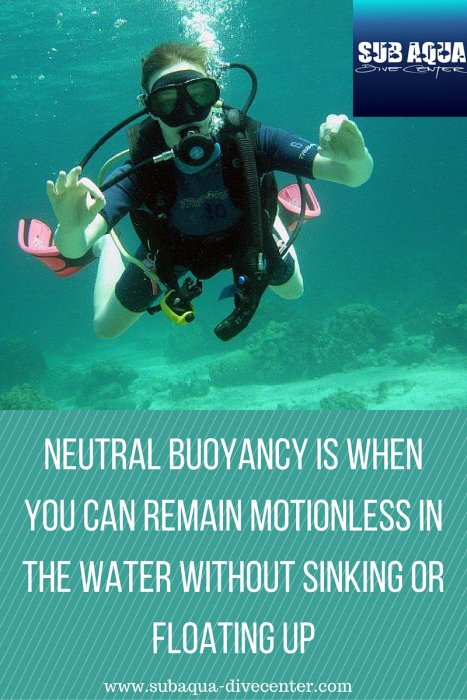Buoyancy Basics Part 2: Positive or Negative?
2017-02-01 12:15:31

Neutral Buoyancy Definition
Ok, so now you've read the
first article of our Buoyancy Basics series, and know that establishing and keeping neutral
buoyancy underwater is of paramount importance. But – you might ask yourself -
how do I know if I have too much negative or positive buoyancy? It's a very good question, because sometimes it's not so easy!
Let's start with a definition.
Neutral buoyancy is when you can remain motionless in the water without sinking or floating up. As simple as that.
Well, maybe not
so simple. Actually, you will always move up and down ever so slightly, with every breath you take. As you breathe, you are constantly changing the volume of air in your lungs, therefore altering your buoyancy. This is normal. You are almost never "
perfectly neutrally buoyant". But the trick is that the distance you move up and down should be more or less equal, and your average depth should stay constant.
The thing is: we are almost never “motionless in the water”. While
diving we are moving around, most of the time, and any movement that you do is going to affect your position in the water, and possibly your depth. Often it's hard to tell whether you have negative, positive, or neutral buoyancy.
So what can you do?
Very simple: if at any moment during the dive you want to
check your buoyancy, do the following: STOP MOVING. Remain absolutely still, don't move your arms and don't kick with your legs. Just breathe naturally, as you do normally during the rest of the dive. Now look at your depth gauge or
diving computer. If after a few breathing cycles you are still at the same depth as you were when you started, congratulations! You are neutrally buoyant. If, on the other hand, you have sunk deeper, it means you have negative buoyancy.
It's really important that you concentrate on not moving your legs when you do this test. Any movement of your legs is likely going to push you upwards, countering any negative buoyancy you might have, and defeating the purpose of the exercise. If you are used to diving with a slightly negative buoyancy (something you might not even realize), then your legs are going to instinctively start moving to try to keep you from sinking. Don't let them.
Also, don't worry if your body position changes. When you are not kicking, your body will tend to find its natural trim. (More
about buoyancy and trim in the next articles of this series!). So you might find yourself getting more vertical or more horizontal in the water when you stop kicking. This is also ok. Just keep still, and check your depth gauge, and see if you start sinking slowly.
This test works at any depth, at any point during the
dive. If you practice and do it often, you will become a lot more aware of yourself and your buoyancy. You will know what it feels like when you have even slightly negative buoyancy, and will not need to stop for more than 2-3 seconds to check yourself.
This exercise of staying still and just breathing is not the only thing you can do, though. There are other clues that can help you determine your buoyancy, and even let you help your buddy to determine his or hers.
For example, if you are negatively buoyant, you will often find yourself bumping against and having to push off from the bottom or the reef. You might also find it difficult to get close enough to look at something small without lying on or holding on to the reef. You might simply just never be able to stay still without kicking and moving forward. As for your buddy, you might notice that their body position is sort of diagonal, with the legs a bit deeper than the torso. You might see that they are lifting a cloud of sand if they swim close to a sandy bottom. Or, you might notice that while your depth is constant, they always seem to sink a bit deeper than you, and then look around scratching their heads, wondering where you went.
If you are too positively buoyant, you will feel like you are always tending to float upwards. However, unlike negative buoyancy, positive buoyancy rarely goes unnoticed, because to compensate it you would have to get into a head down, feet up position, and kick downwards. This feels very unnatural, and you will very quickly realize that something is wrong. The problem with negative buoyancy is that our natural position on land, when not diving, is head up, feet down. So it doesn't feel “wrong” when you drop your legs and kick upwards to instinctively compensate for a slightly negative buoyancy, because it's the same head-up-feet-down position that we're so used to. That's why sometimes it's difficult to tell when you have become negatively
buoyant during a
dive.
But now you know how to check yourself, and in the next article you will find out what to do about it, if you find that you do not have neutral buoyancy. So KEEP TUNED!
At
SUB AQUA DiveCenters we strive to offer the best possible service to our
divers, and that includes helping them to
improve their buoyancy, if they wish. So come diving with us, and don't be shy: ask questions, ask for help and advice! Our instructors will be happy to assist you.
Or take a
PADI Peak Performance Buoyancy Specialty Course, if you really want some practice time with an instructor.
Continue reading -
Part 3: How do I correct my buoyancy while scuba diving?


